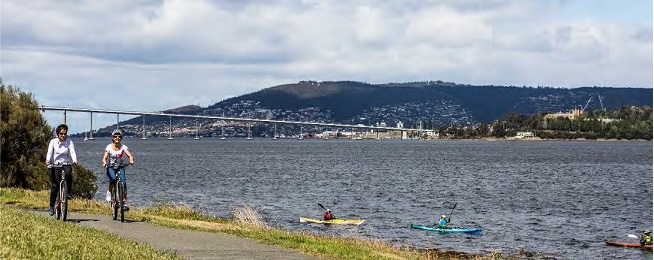The Greater Hobart Committee has released for public comment a 30 year plan to guide transport and housing decisions as the population increases.
The committee comprises the Tasmanian Government and four greater Hobart Councils: Hobart, Glenorchy, Clarence and Kingborough and was formed under the Greater Hobart Act.
The central thrust of the plan is to encourage greater residential density to enable more efficiencies in transport and other infrastructure.
This mirrors the push that’s been happening in other capital cities to create “walkable” neighbourhoods where shops, employment, parks and services are within a 20 minute walk of where you live.
The areas it picks out for this increased density include central Hobart, the northern suburbs transit corridor, Droughty Point, and Huntingfield, Margate and Snug.
Of the policy directions identified in the plan, the most relevant for people who want to ride for transport are:

The plan is accompanied by a Strategy for Growth and Change paper which further fleshes out some of the directions in the plan.
The strategy acknowledges the existing community desire for better cycling infrastructure.
“The walking and cycling networks that permeate Hobart are highly valued and there is a desire within the community that they be extended and enhanced.”
But it doesn’t come out and set any firm targets to build the links needed to create a cohesive network. Instead deferring to the development of the Greater Hobart Commuter Cycling Network, which is being worked on by a committee of council and government employees.
It also includes a somewhat confusing map showing existing cycle routes, mixed in with current on-road lanes and separated paths and potential legs of an arterial cycling network.
The focus on an arterial network is consistent with past planning approaches and can go some way but not all the way to achieving the stated desire of the plan to create walkable, 20-minute neighbourhoods and to encourage people to live closer to where they work.
The strategy also acknowledges the rise in the number of people working from home and transport networks should acknowledge the need for more localised trip routes within suburban centres.
What should we support in the plan?
While the plan provides general direction on where Hobart should go with land use planning it doesn’t provide any tangible targets, this part is supposed to come in the Implementation Plan which has not been completed yet.
It’s imperative that the Greater Hobart Commuter Cycling Network is finalised as soon as possible so it can be incorporated either into this plan or the implementation plan and people get the chance to comment on it.
Without having this network incorporated into the plan there isn’t much more to comment than there was in the vision that was released last year.
Although, we should all provide supportive comments around the Optimise Public Accessibility directions as they provide the framework to implement a transport cycling network.
Have your say on 30 year plan
You can read the documents and fill out the online survey before 20 June.
Online survey

